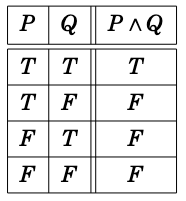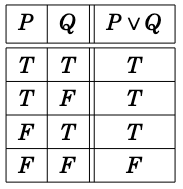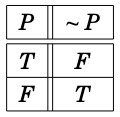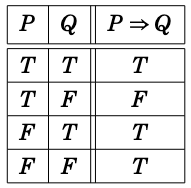


A1
Reminder: due Friday. We covered everything you need as of yesterday.
Reminder: you must submit a PDF generated by LaTeX from the provided .tex template. See the guide and come to office hours if you’re having trouble.
Lab 1 is due Sunday night
Siddhu’s office hours are posted - Thursday 12-12:30; Arun’s still TBD
Definition: A statement is an English sentence or mathematical expression that is either definitely true or definitely false. That is, a statement has a definite truth value (true or false).
Examples:
| Sentence/Expression | Statement? |
|---|---|
| Add \(5\) to both sides | No |
| \(\mathbb{Z}\) | No |
| Adding \(5\) to both sides of \(x-5=37\) gives \(x=42\) | Yes |
| \(42 \in \mathbb{Z}\) | Yes |
| \(42\) | No |
| What is the solution of \(2x=84\)? | No |
| The solution of \(2x=84\) is \(41\) | Yes |
| \(42\) is not a number | Yes |
| \(x\) is a multiple of \(8\) | No |
This last one,
\(x\) is a multiple of \(8\)
has a truth value that depends on the value of \(x\). Thus - by itself - it’s not definitely true or false, and is not a statement. But if you give me a value for \(x\), it becomes a statement because that value is either a multiple of 8 or it is not. This is an example of…
Definition: an open sentence is a sentence or expression that is not a statement because its truth value depends on one or more variables.
A sentence can be a statement even if we mortal humans don’t know which!
Nonexample:
it is not cloudy
This isn’t a statement because its truth value depends (for example) on where in the world you are - there is no secret unknown “true” value of whether it is cloudy - it is not definitively true or false. To make it a statement, you’d need to say something more specific.
Example: The Collatz Conjecture
Start with a positive integer \(x\). Repeat the following:
- if \(x\) is even, divide it by 2 (\(x \leftarrow x / 2\))
- if \(x\) is odd, multiply \(x\) by 3 and add 1 (\(x \leftarrow 3x + 1\))
Given any initial positive integer \(x\), after iterating this a finite number of times, \(x\) becomes 1.
This is a statement (it’s either true or not). But nobody has figured out which!
Do Exercises Part A
Three important logical operators that operate on statements:
The following show truth tables, where the last column is the value of the expression for the given value(s) of the input(s) in the left column(s).



Do Exercises Part B
Here’s the truth table for the conditional operator:

The usual interpretation of \(P \Rightarrow Q\) is to mean “if \(P\) then \(Q\)”, or “\(P\) implies \(Q\)”
Notice: this does not commute.
Notice: If false, then anything! This gets weird sometimes.
\(P\) : If I am healthy, then I will come to class.
Suppose you are sick; then the statement “If I am healthy, then I will come to class” is true whether or not you come to class.
Mental model suggestions:
Do Exercises Part C
Equivalent ways of writing “if \(P\) then \(Q\)”:
Definition/aside: “If \(Q\) then \(P\)” is the converse of “If \(P\) then \(Q\)”.
Do Exercises Part D
Biconditional - “\(P\) if and only if \(Q\)”: \(P \Leftrightarrow Q\)
This means \(P \Rightarrow Q\) and \(Q \Rightarrow P\) are both true.